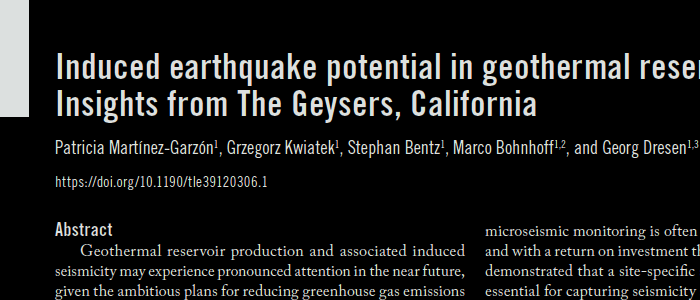Patricia Martínez-Garzón and I published a manuscript entitled “Induced earthquake potential in geothermal reservoirs: Insights from The Geysers, California” in The Leading Edge. The article provides an exciting overview of our past research on induced seismicity associated with the biggest geothermal field in the world. It was a real fun to recapitulate all the knowledge we gained while analyzing this vast dataset, reminding countless stimulating discussions and feedback gained during conferences. The publication confronts The Geysers induced seismicity experience with outcomes of our recent works on St1 Deep Heat induced seismicity, and discusses potential first-break seismo-mechanical parameters that allows for identification of EGS systems that are prone to runaway ruptures.
Abstract:
Geothermal reservoir production and associated induced seismicity may experience pronounced attention in the near future given the ambitious plans for reducing greenhouse gas emissions towards a carbon-neutral economy and society. At some geothermal sites, the occurrence of hazard and risk-prone induced earthquakes caused by or associated with reservoir stimulation resulted in project shut-down (e.g. Pohang, South Korea and Basel Deep Heat Mining, Switzerland). In contrast, at other geothermal sites the maximum event magnitudes were successfully maintained below a threshold defined by local authorities (e.g. St1 Deep Heat in Finland). In this study, we review some of our results from seismological and geomechanical reservoir characterization at The Geysers geothermal reservoir in California, USA, the largest producing geothermal field worldwide. We relate our findings to other geothermal sites to better understand the variability of reservoir behavior. In particular, we obtain a constant and relatively low seismic efficiency at The Geysers, which is interpreted to be related to the large energy dissipation through thermal processes and additional dissipation through aseismic slip, the latter now being considered to play a fundamental role in earthquake nucleation. We discuss some characteristics of the seismicity from The Geysers suggesting stable reservoir seismic injection efficiency, and possibly lower potential to rupture into larger induced earthquakes reducing the associated seismic hazard.
Reference:
Martínez-Garzón, P., G. Kwiatek, S. Bentz, M. Bohnhoff, and G. Dresen (2020). Induced earthquake potential in geothermal reservoirs: Insights from The Geysers, California. The Leading Edge 39, 873–882, DOI: 10.1190/tle39120873.1. [ Article page ]
